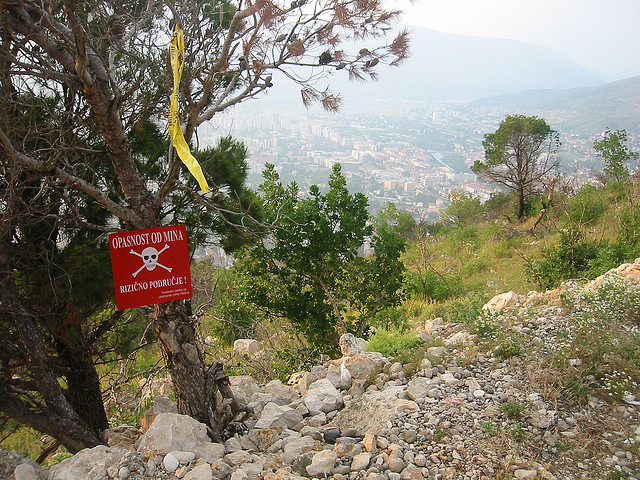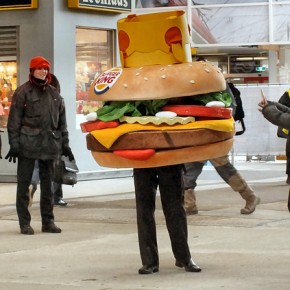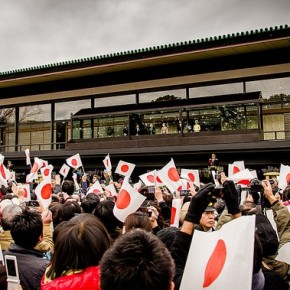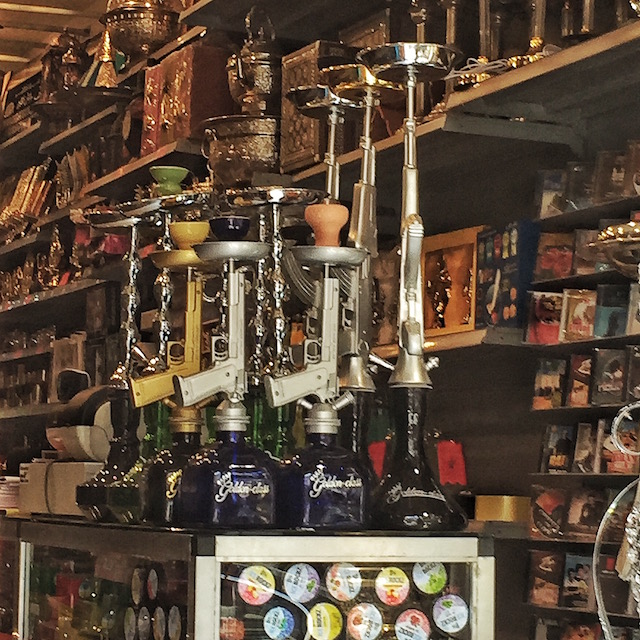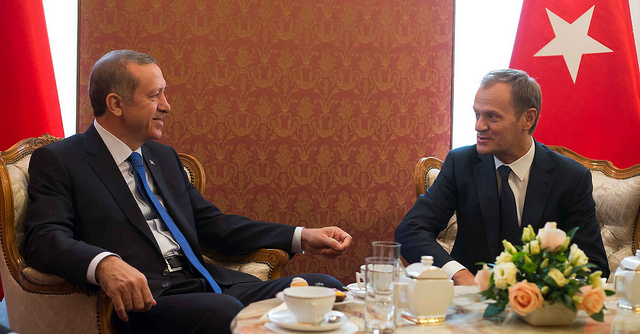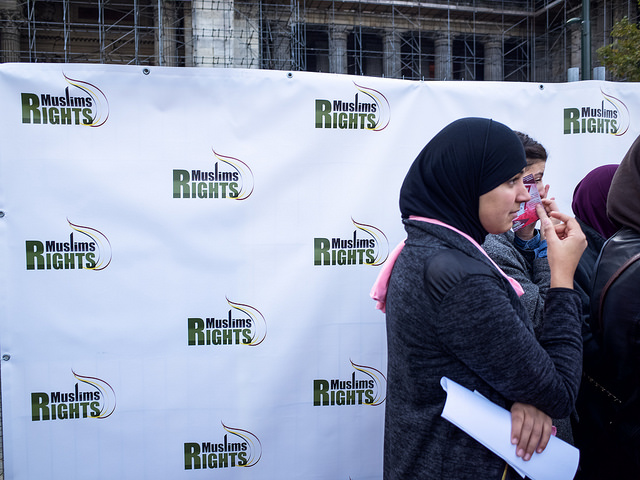Bogdan Bogdanovich’s Partisan Memorial Cemetery should be Mostar‘s second major tourist attraction. Built in 1960, the park is something between a memorial, and Gaudi’s Park Buell. High stone walls climb narrow paths in disorienting labyrinths. Ramps lead to a plateau engraved with stone flowers, the nameless graves of Partisans who fought against the Croatian Ustasha, Mussolini, and the Nazis.
An uvula-shaped courtyard in the center is ideal for memorial services, such as the kind Mostar’s Antifa group hold yearly on May 9th, the date of Nazi capitulation.
This year, they were greeted by a barricade of burning tires. “Older people couldn’t believe it,” one of Mostar’s few organized antifascists told me. “Why would anyone do this?” But judging from the state of the cemetery, opposition to its memory is not all that surprising.
Completely overgrown with weeds, littered with used condoms and beer bottles, and covered with fascist graffiti, the Partisan Memorial Cemetery is both a testament of Bosnia’s socialist struggle against fascism, and the erasure of this history that came with Croatia’s right-wing turn during its war of independence. Monuments to socialism and the anti-Fascist struggle were destroyed throughout the country. Ethnic minorities were purged or sent to concentration, death, and rape camps. Mostar was split through the middle by this all-too-recent Hell on Earth.
An initial alliance between Croat and Bosnian Muslims broke down after a deal between Franjo Tudjman and Slobodan Milosevic to divide Bosnia between their fledgling nations. Bosnian Muslims were purged from the Croatian military and sent to starve in concentration camps, and Croatian Bosnians started a war of ethnic cleansing and extermination against the Muslims in Mostar.
Initially the city was somewhat mixed, but as tensions flared, Muslims and Catholics exchanged houses, and East and West Mostar became almost completely homogenous. When the offensive started, the Bosnian army controlled the western hills through the river, but were outgunned by the Croatian army on the eastern hill. Shells landed near schools, and in markets. Every bridge connecting Muslim Mostar to the front line. A street with apartment buildings converted to bunkers on each side was eventually destroyed.

Many of the buildings destroyed by mortars and arson are still in a post-war state of ruin. The most famous of these are on Alekse Santica utica, which also boasts Mostar’s lone ethnically-neutral social center: Abrasovic.
Originally a squat, Abrasovic is not the stereotypical anti-fascist space. There are no stickers or slogans painted on the walls, no fliers for punk or hip hop shows, and its huge back-room venue is used more often for pilates and stand-up comedy than for solidarity concerts or political meetings. If you sit with some strangers and try to talk politics, you might get a cold response. Mostar’s youth, even those who lean left, are understandably exhausted of constant talk of the war, and Abrasovic is one of the few places Croats and Muslims can gather without fear of violence. On that evening volunteers were collecting buckets of rubble from an old bunker to build a half-pipe.
Even by American backpacker standards, my trip to Bosnia was bumbling from its start. At a rest stop before the border, I took a few seconds too long to choose how to spend my list Kuna, eventually settling on a small bottle of schnapps. When I emerged from the roadside kiosk, my bus was driving away. I bolted towards it as fast as I could, almost instantly tripping, scraping my knee and side as I skidded on the asphalt. Someone on the bus must have noticed my absence, because it stopped and waited for me to dust myself-off and hobble on board. No apologies from the driver, and only a few sympathetic stares from the other passengers, I pulled my towel from my bag to close the lightly-bleeding scrape, and used half the bottle of liquor to sanitize it.
Soon after I was in the dusty outskirts of West Mostar. With its socialist-looking municipal buildings, some of them intact and others burnt out, uncleaned streets, and sleepy cafes and bakeries, I felt like I had landed in some post-apocalyptic frontier town. Such impoverished malaise is a common site in the Balkans, but as I walked farther into town, Turkish ambience and friendliness of strangers heightened the fantasy-world feeling. On three occasions, strangers offered me directions. One invited me to a game of chess. I made my way through back-streets to my hostel, and cleaned myself up. For my first day in Mostar, everything I had seen aside from the decades-old destroyed buildings, was heartwarming and pleasant. The next morning I took the “City War Tour.”
The tour is organized by the co-owner of my hostel, who nearly every day escorts clueless backpackers through the stale ruins and trauma of their youth. On the 10 Euro, two hour tour, Amar, a somewhat macho football fan and professional street artist, showed us where his grandfather, a Partisan veteran of World War II, was shot and killed. In a parking lot nearby, his elementary school classmates was directly hit by a shell, and Amar caught a chunk of it in his leg. Nearby, he showed us the government building where nearly all the children in town lived together in the basement.

In the city center, he showed us exquisitely rebuilt municipal buildings. “Why did they spend so much money on the town hall, when across the street half the town is still destroyed?”
I asked him if he took part in the protests there in February, when a worker’s protest against factory closures in Tuzla turned into a general revolt against the government. “Yes, I was there. No one has any faith in the government. We have received many millions from the UN, Turkey, Italy, and all around the world to rebuild and the politicians just keep it for themselves.”
The antifascist I talked to described how the politicians spun the protests through the media. A Bosnian Croat paper said Muslims were crossing into the West to attack Croatian homes and businesses, despite only municipal buildings being targeted with the participation of Croat unions. Other media sources dismissed the protests as hooliganism.
Bosnian political analyst Florian Bieber describes the general feeling, “the strategy of talking to six party leaders and thinking that this is the way to change Bosnia for the better has failed and should be over.” As they fled the country, it became clear the political elite were afraid, not only for the property (several of their cars were pushed into the Sarajevo canal,) but for the bankrupt ethnonationalist ideology that keeps them in power.
“When people ask me if I’m Muslim, Croatian, or whatever, I say I’m Yugoslavian. We never had this question before,” said Amar as we approached Mostar’s main attraction.
“This bridge is crowded now, but during the winter, no one is here. No one makes any money during the Winter. We used to have a lot of jobs here, many factories.” These too were a casualty of the war.

On the eastern side of the bridge, Amar took us to a book and gift shop that showed a ten minute documentary looping on a TV set. The bridge is shown badly damaged, held together with metal wires and tires. Soldiers and journalists duck and run across the last-remaining crossing to the bunkers on the front line. Then, footage shows mortars finally taking-out the bridge. The image of concrete chunks splashing into the river below depicts a encapsulates the conflict’s tragedy, making it easily comprehensible to those who have never experience war.
The concentration camps, town-to-town slaughters, and shelling of markets are outside tourist understanding, but the destruction of monuments is somehow immediate, and all the more so considering I had just traversed them. It is as though the video was a fiction, a cartoon even, where a princess’ plight absorbs all the horror and ideology into a brief cathartic myth.
Armed conflict ceased after the 1995 Dayton Agreement, but the economic and personal violence still continued. In ’95, West Mostar formed their own football club, Ultras, whose imagery incorporates Croatian fascist symbols and who has a fan club called Ustiche. East Mostar’s team is the Red Army, a pro-Yugoslavian group. The ethno-nationalism still simmers in the graffiti wars and brawls between fans, most of them the children of the war.
Especially in opposition to the east side’s oriental charm, West Mostar was a boring and posh suburb lined with Starbucks-style cafes and upscale eateries. I passed a bar dedicated to Mostar’s Croat football team established in 1994, a hulking skinhead waving a Croatian flag painted on its wall (Bosnian Muslims like Amar root for the Red Army, a team established in the 1950s that uses soviet and anti-fascist imagery).
As I walked farther down the street, someone in a car splashed a bottle of water on me, I assume because I look somewhat punkish. As I walked to the cemetery for Croatian veterans, locals watched me with curiosity from my window. Later, one person refused to give me directions when I was looking for the Partisan Cemetery. There were so many White Pride stickers along my way, I gave up on scratching them off.
Back at Abrasovic, there was no one to commiserate with. Teenagers smoked joints and played guitar, students drank beer, and a few older folks played backgammon. It was a lively Tuesday night, but I was numb from my tour of the town. I went to the closest grocery store and bought a four Mark bottle of Raki. I walked to an area on the Neretva river below the bridge where men fish, tourists take photos and drink, and families watch the sunset.
The bridge was lit up with white and blue lights, making the whole impoverished and war-torn scene seem like Cinderella’s idyllic castle. But the video of the bridge’s destruction was fresh in mind. I laid back, my head on grass and my legs dangling off flat rock jutting over the water. Some French tourists behind me laughed, joking that I might be dead.
Part III in a series. Photographs courtesy of Steffen Emrich, Tomas Vanco and Corbin Keech. Published under a Creative Commons license.
